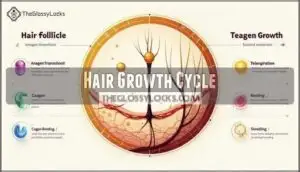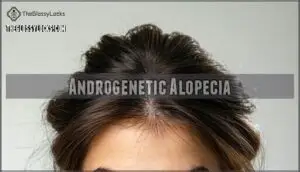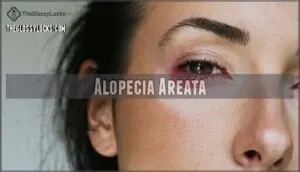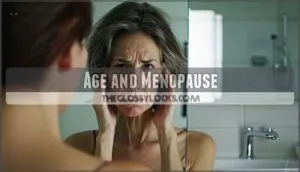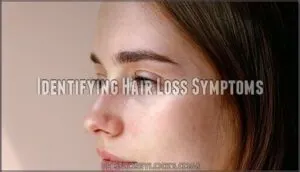This site is supported by our readers. We may earn a commission, at no cost to you, if you purchase through links.

You’re likely dealing with androgenetic alopecia if thinning runs in your family, or telogen effluvium when stress throws your hair cycle out of whack.
Hormonal changes during pregnancy, menopause, or thyroid issues can trigger unexpected shedding.
Medical conditions like PCOS, autoimmune disorders, and certain medications also play troublemaker roles.
Nutritional deficiencies, particularly iron and protein, don’t help matters either.
Your hair’s basically sending an SOS signal about what’s happening inside your body, and recognizing these patterns opens doors to targeted solutions.
Table Of Contents
- Key Takeaways
- Female Hair Loss Causes
- Hair Growth Cycle
- Types of Female Hair Loss
- Hair Loss Risk Factors
- Identifying Hair Loss Symptoms
- Frequently Asked Questions (FAQs)
- How common is hair loss in women?
- What causes hair loss in women?
- What causes baldness in women?
- What is female pattern hair loss?
- Is hair loss a male or female problem?
- What causes hair loss & pattern baldness?
- What is the solution for hair loss?
- Why is my hair thinning on the sides female?
- How to tell if hair loss is stress related?
- How can I stop my hair falling out as a female?
- Conclusion
Key Takeaways
- You’re likely dealing with androgenetic alopecia if hair loss runs in your family – This genetic condition affects 30 million American women and causes follicles to shrink when exposed to hormones, creating gradual thinning that typically starts at your crown.
- Hormonal changes during major life events trigger unexpected shedding – Menopause, pregnancy, thyroid disorders, and PCOS can disrupt your hair’s natural growth cycle, causing noticeable hair loss that often appears 2-3 months after the triggering event.
- Stress and medical conditions send your hair into early rest mode – Chronic stress, autoimmune diseases, anemia, and certain medications can push your hair follicles into telogen effluvium, causing excessive shedding beyond the normal 50-150 hairs per day.
- Nutritional deficiencies starve your follicles of essential building blocks – Iron, protein, vitamin D, and B-vitamin deficiencies can disrupt your hair’s growth cycle, making proper nutrition and addressing deficiencies crucial for maintaining healthy hair growth.
Female Hair Loss Causes
You’re not imagining it if you’ve noticed more hair on your brush or in the shower drain lately.
Female hair loss affects 30 million American women and stems from five main medical causes that range from genetics and hormones to stress and underlying health conditions.
This condition is a significant issue, and understanding its causes is crucial for addressing it effectively.
Genetic Factors
Your DNA holds the blueprint for female hair loss.
Your genes write the story of your hair’s future before you’re even born.
Androgenetic alopecia, or female pattern baldness, runs in families through inheritance patterns involving androgen receptors.
If your mother or grandmother experienced thinning hair, you’re more likely to face similar challenges.
Gene mutations affect how your follicles respond to hormones.
Family history serves as your strongest predictor for hereditary hair loss patterns.
Hormonal Changes
Your hormones act like hair’s personal cheerleaders.
When estrogen and progesterone levels drop during menopause, your hair follicles shrink and produce thinner strands.
PCOS floods your system with androgens, triggering female hair loss.
Thyroid disorders disrupt your hair’s growth cycle.
Pregnancy shedding happens postpartum when hormone levels crash.
DHT sensitivity can also lead to hair thinning.
Hormone therapy can help restore balance.
Stress and Trauma
Life’s curveballs can literally knock the hair off your head.
Life throws punches, and sometimes your hair takes the hit.
Emotional shock, surgery-related shedding, and chronic stress effects trigger telogen effluvium, pushing hair follicles into early rest mode.
Postpartum hair loss affects many new mothers, while trauma-induced shedding occurs after major life events.
Your body prioritizes survival over hair growth during stressful periods, causing noticeable female hair loss.
A possible contributing factor to this shedding could be Vitamin D deficiency, related to overall hair growth issues.
Medical Conditions
Beyond stress, underlying medical conditions often trigger female hair loss.
Thyroid disorders disrupt your hair’s growth cycle, while autoimmune diseases like lupus attack hair follicles.
PCOS hair loss stems from excess androgens, and anemia starves follicles of essential nutrients.
Scalp infections create inflammation that damages roots.
These chronic illnesses require proper diagnosis and treatment to restore healthy hair growth.
By age 50, many women experience noticeable hair loss, which can be caused by various underlying medical conditions and can lead to significant hair loss issues.
Medications and Treatments
Certain medications can trigger hair loss as an unwanted side effect.
Blood thinners, antidepressants, and birth control pills may disrupt your hair’s natural growth cycle.
Chemotherapy treatments cause dramatic hair loss by targeting rapidly dividing cells.
Some acne medications and high-dose vitamin supplements also contribute to thinning. Always discuss potential hair loss risks with your doctor before starting new treatments.
Hair Growth Cycle
Your hair follows a natural three-stage cycle that determines when strands grow, rest, and eventually fall out.
Understanding this cycle helps explain why you lose 50 to 150 hairs daily and why disruptions can lead to noticeable hair loss.
This knowledge is crucial for maintaining healthy hair, as it provides insight into the natural processes that govern hair growth and shedding.
Anagen Phase
The anagen phase represents your hair’s powerhouse period, where follicles actively produce new strands.
This growth stage typically lasts 2-8 years, with healthy anagen cycles determining your hair’s maximum length potential.
Anagen genetics influence how long this phase continues, while anagen disruption from stress or medical conditions can trigger premature telogen effluvium and increased hair shedding patterns.
Catagen Phase
After your hair finishes growing, it enters the catagen phase – a brief but important stage lasting 2-4 weeks.
During this catagen duration, your hair follicles shrink and separate from their blood supply, basically cutting off nutrition.
This follicle shrinkage signals the end of active growth, while this phase affects only 1-3% of your hair at once, it’s a natural part of healthy hair growth cycles.
Telogen Phase
The telogen phase marks your follicle’s resting period, lasting 2-4 months with about 10% of your hair in this stage.
During telogen duration, follicles prepare for new growth while old strands loosen.
Shedding triggers like stress can push more follicles into telogen effluvium, causing excessive hair loss.
This natural part of hair growth cycles affects all women differently, and understanding hair loss is crucial for managing its impact.
Hair Shedding and Regrowth
After resting follicles release old strands, your body starts fresh growth cycles.
Normal shedding volume ranges from 50-150 hairs daily, while regrowth rate depends on follicle health and hormonal balance.
Seasonal shedding often increases in fall, and postpartum regrowth can take months to normalize.
Understanding this natural process helps distinguish between typical hair loss in women versus concerning anagen effluvium requiring medical attention.
Types of Female Hair Loss
You’ll encounter four main types of female hair loss, each with distinct patterns and causes that affect women differently.
Understanding these types helps you identify what’s happening with your hair and guides you toward the right treatment approach, which is crucial for addressing female hair loss.
Androgenetic Alopecia
Most women with androgenetic alopecia inherit genes that make hair follicles sensitive to DHT.
This female pattern baldness affects 30 million American women, causing a gradual miniaturization process where healthy hair becomes thin and wispy.
The psychological impact can be significant as your hairline slowly recedes over decades, unlike men’s Norwood Scale patterns.
Telogen Effluvium
Following major life events like childbirth or surgery, you might experience stress-induced shedding called telogen effluvium.
This condition pushes hair follicles into the telogen phase prematurely, causing noticeable hair loss three months later.
Postpartum hair loss affects many new mothers, and hormonal shifts can also disrupt hair growth cycles, as seen in Hormonal shifts.
Trigger identification helps determine causes, while the recovery timeline typically spans six months with proper preventative measures, leading to a better understanding of telogen effluvium.
Anagen Effluvium
Unlike other hair loss types, anagen effluvium strikes during your hair’s active growth phase.
This aggressive condition typically results from chemotherapy effects or radiation therapy that cause direct follicle damage.
Three main characteristics include:
- Rapid shedding within days or weeks of treatment
- Complete hair loss across the scalp and body
- Hair regrowth potential once treatment stops
Treatment options focus on protecting remaining follicles.
Alopecia Areata
Beyond genetics and hormones, alopecia areata strikes when your immune system mistakenly attacks hair follicles.
This autoimmune condition creates smooth, coin-sized bald patches that can appear overnight.
While autoimmune triggers remain mysterious, patch regrowth often occurs spontaneously within a year.
The emotional impact can be significant, but treatment efficacy continues improving as research advances uncover new therapeutic approaches for managing this unpredictable scalp condition.
Hair Loss Risk Factors
Several key factors can increase your chances of experiencing hair loss, and understanding these risks helps you take preventive steps.
Your age, family history, daily habits, and nutrition all play important roles in determining whether you’ll face thinning hair or balding patterns.
Age and Menopause
As you age, your hair follicles naturally slow down their production cycle, leading to thinner strands and reduced hair density.
During menopause, estrogen decline triggers significant hormonal shifts that accelerate follicle aging.
Post-menopause hair loss affects up to 50% of women by age 50, making age-related hair loss one of the most common causes you’ll encounter.
Family History
Your family tree holds clues about your hair’s future. Genetic predisposition plays a major role in female hair loss, with inherited traits passed down through generations.
Here’s how ancestry impact affects alopecia risk:
- Maternal lineage – Hair loss genes often come from your mother’s side
- Paternal influence – Father’s family history also contributes to heredity patterns
- Multiple generations – Grandparents’ hair patterns predict your genetic factors
- Early onset – Family history of young hair loss increases your risk
Biotin deficiency disrupts hair growth, so it’s important to take into account nutrient deficiencies in your family history.
Lifestyle Factors
Your daily choices substantially impact hair health.
Smoking restricts blood flow to follicles, while harsh styling practices create traction that damages roots over time.
Poor scalp health from infrequent washing or product buildup clogs follicles.
Environmental exposure to pollutants and UV rays weakens hair structure.
Using a scalp massager tool can improve circulation.
Managing stress through exercise and adequate sleep helps maintain healthy growth cycles.
Nutritional Deficiencies
When your hair starts falling out, poor nutrition might be the culprit.
Iron deficiency and vitamin D deficiency are common causes of female hair loss.
Vitamin deficiencies, especially B vitamins and biotin, can disrupt your hair’s growth cycle.
A balanced diet with adequate protein intake supports healthy follicles.
Consider addressing potential deficiencies with supplements.
Biotin supplements may help, but consult your doctor first.
Identifying Hair Loss Symptoms
You can recognize hair loss by watching for key warning signs that signal something’s changed with your normal hair growth pattern.
Look for more hair than usual in your shower drain, on your pillow, or in your brush, along with noticeable thinning areas or a widening part line on your scalp.
Excessive Shedding
When you notice more strands than usual in your brush, you’re experiencing excessive shedding that goes beyond normal hair loss.
Several shedding triggers can cause this:
- Seasonal shedding – Often occurs during fall months
- Postpartum shedding – Common 3-6 months after childbirth
- Stress-related episodes – Physical or emotional trauma
- Medication changes – New prescriptions affecting hair cycles
Shedding severity and duration help determine underlying causes.
Thinning Hair
Gradual thinning hair often sneaks up on you, making early detection essential for effective intervention.
You’ll notice your ponytail feels less full or your scalp becomes more visible through strands.
This overall thinning differs from patchy hair loss in women, typically starting at your crown.
Thinning prevention strategies and volume enhancement techniques can address psychological impact while maintaining confidence through styling solutions and considering the psychological impact.
Bald Spots and Patches
When circular bald spots appear suddenly on your scalp, you’re likely experiencing alopecia areata, an autoimmune condition affecting millions of women.
These patches may feel itchy or painful before hair disappears completely.
Fungal infections can also create patchy hair loss with scaling and redness.
Scarring alopecia causes permanent damage, making early detection essential for preserving your remaining hair follicles, and it is crucial to address this condition to prevent further hair loss.
Receding Hairline
Unlike localized bald spots, receding hairlines affect your entire frontal area.
This female baldness pattern differs from typical androgenetic alopecia, creating distinctive early hairline signs that require attention.
Watch for these hairline recession causes:
- Forehead expansion – Your hairline moves backward from temples
- Widow’s peak changes – Central hairline point becomes more pronounced
- Temple thinning – Side areas show visible scalp
- Frontal density loss – Overall hairline appears wispy
Hairline treatment options and concealing methods can address these concerns effectively. Early diagnosis can help with effective hairline management.
Scalp Conditions and Infections
Scalp conditions and infections create visible signs beyond simple hair thinning.
Fungal infections like ringworm cause scaly patches, while folliculitis produces painful bumps.
Scalp psoriasis creates red, flaky areas, and seborrheic dermatitis causes inflammation.
These conditions often require a scalp biopsy for proper diagnosis.
Scarring alopecia from severe infections can permanently damage hair follicles, making early treatment essential.
Effective solutions include specialized fungal treatments, which can help manage fungal infections and prevent permanent damage.
Frequently Asked Questions (FAQs)
How common is hair loss in women?
Hair loss affects you more than you’d think. About 50% of women experience noticeable thinning by age 50, with 30 million American women dealing with female pattern baldness alone.
What causes hair loss in women?
Your hair loss stems from several factors: genetics, hormonal changes during menopause or pregnancy, stress, medical conditions like thyroid disorders, certain medications, tight hairstyles, and nutritional deficiencies affecting your follicles.
What causes baldness in women?
Female pattern baldness stems from genetics and hormone sensitivity.
Your hair follicles shrink when exposed to androgens, producing thinner strands.
Menopause, stress, medical conditions, and certain medications can also trigger balding patterns in women.
What is female pattern hair loss?
Androgenetic alopecia affects you when your hair follicles become sensitive to hormones, causing gradual thinning on your crown.
You’ll notice a widening part and thinner ponytails as follicles shrink over time.
Is hair loss a male or female problem?
Both men and women experience hair loss, but patterns differ.
You’ll notice men typically lose hair around their hairline and crown, while women see thinning across the top of their scalp with widening parts.
What causes hair loss & pattern baldness?
Like leaves falling from a tree, your follicles cycle through growth phases.
Genetics triggers pattern baldness when androgen hormones shrink follicles.
Stress, hormones, medications, and styling damage also cause shedding beyond normal daily loss, which can be considered as normal daily loss variation.
What is the solution for hair loss?
You can explore treatments like minoxidil for regrowth, spironolactone to block hormones, or hair transplants for permanent results.
Address underlying causes first—thyroid issues, stress, or nutritional deficiencies often need correction before hair improves, considering complete concepts like these can be crucial.
Why is my hair thinning on the sides female?
Side-specific shedding suggests several scenarios.
You’re likely experiencing traction alopecia from tight hairstyles, sleeping patterns, or hormonal changes affecting specific areas.
Consider gentler styling methods and consult a dermatologist for proper diagnosis.
How to tell if hair loss is stress related?
You’ll notice sudden, excessive shedding 2-3 months after a stressful event. Hair falls out in clumps during washing or brushing. Stress-related loss affects your entire scalp uniformly, not specific patterns.
How can I stop my hair falling out as a female?
You can reduce hair loss by using minoxidil, managing stress, eating protein-rich foods, taking iron supplements if deficient, avoiding tight hairstyles, and consulting a dermatologist for personalized treatment options.
Conclusion
Research shows that 50% of women experience noticeable hair thinning by age 50.
Understanding the causes of hair loss in females empowers you to take proactive steps toward healthier hair.
Whether you’re dealing with genetic predisposition, hormonal fluctuations, or medical conditions, early identification leads to more effective treatment options.
Don’t ignore persistent shedding or sudden changes in your hair’s thickness, and consult your healthcare provider to determine the underlying cause and develop a personalized treatment plan that addresses your specific needs.

